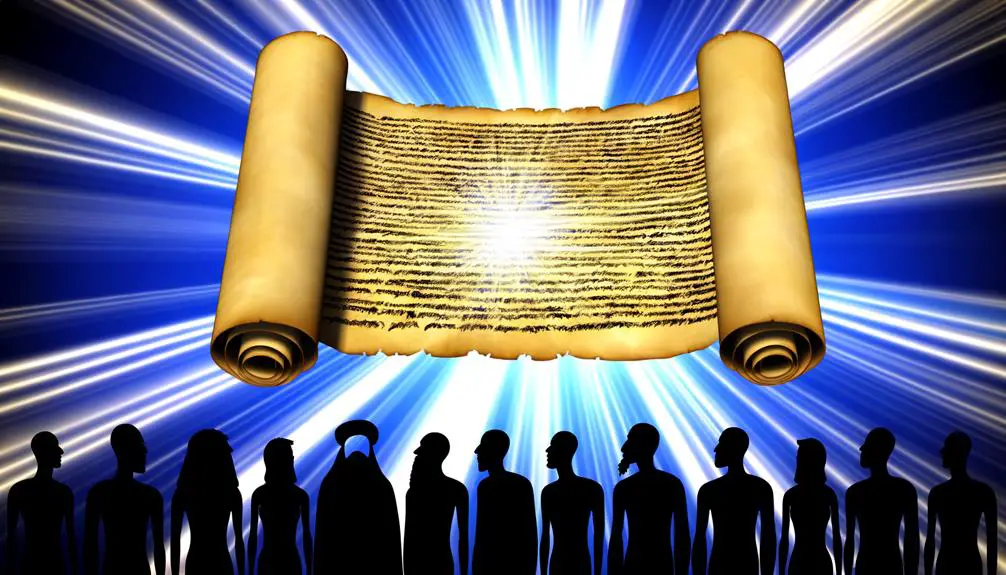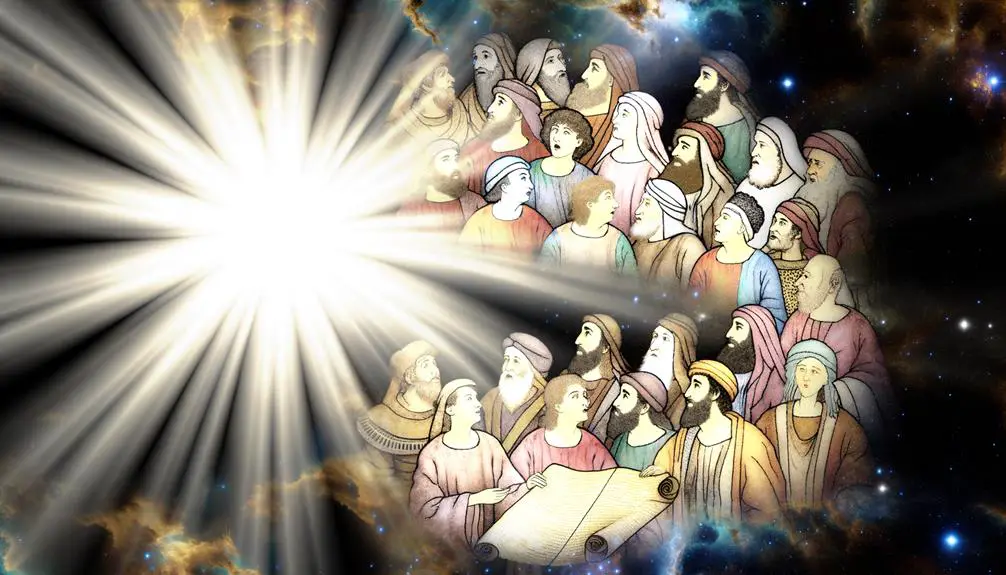Witness how the archaic term 'shewed' unveils layers of divine revelation in the Bible, inviting deeper exploration into its timeless narratives.

Shewed Meaning in the Bible
Did you know that the term 'shewed' appears over 200 times in the King James Version of the Bible?
This archaic term, essentially meaning 'showed' or 'revealed,' plays a pivotal role in understanding divine communication and human experiences with the divine throughout biblical narratives.
As you explore the historical context and the nuanced ways 'shewed' is woven into stories of revelation and response, you'll uncover layers of meaning that could shift your perception of familiar biblical tales.
The question now is, how does this ancient expression shape our modern understanding of revelation, and what might we discover about our own responses to the divine?
Key Takeaways
- 'Shewed' in the Bible often refers to the revealing of divine will or truths to humanity.
- It is considered an archaic term, now commonly replaced by 'showed' or 'revealed'.
- Understanding 'shewed' requires insight into historical and cultural contexts of biblical narratives.
- The term bridges ancient divine communications with contemporary interpretations and challenges.
Historical Context of 'Shewed

Exploring the historical context of 'shewed' in the Bible reveals its significance in conveying divine revelations and human experiences. You'll find that this term, steeped in linguistic evolution, serves as a bridge between ancient narratives and contemporary understanding. The journey of 'shewed' through the ages highlights the complexities and beauty of translation challenges faced by scholars striving to maintain the original essence of biblical texts.
Delving deeper, you uncover that 'shewed,' now considered archaic, was once a common term in English translations of the Bible, primarily used to denote the act of revealing, making known, or displaying. Its usage reflects the linguistic norms of the time, particularly in influential versions like the King James Bible. This choice of word, intricate in its simplicity, encapsulates the multifaceted process of divine communication with humanity, underscoring the importance of revelation in the biblical context.
The translation challenges associated with 'shewed' aren't merely linguistic but also theological. Translators must navigate the nuanced connotations of revelation, ensuring that the modern renditions resonate with the original intent and spiritual depth. This task underscores the dynamic nature of biblical languages and the continuous effort to render scriptures accessible to contemporary audiences while retaining their profound theological implications.
As you ponder the historical trajectory of 'shewed,' you're drawn into a broader reflection on the linguistic evolution within biblical translations. Each choice, each term, and each adaptation isn't just about linguistic preference but about bridging the gap between ancient texts and modern seekers of wisdom. This journey through the historical context of 'shewed' not only enriches your understanding of biblical language but also enhances your appreciation for the meticulous care invested in preserving its sacred messages through the ages.
Shewed' in Biblical Narratives

In biblical narratives, the term 'shewed' plays a pivotal role, revealing divine truths and human responses through its linguistic versatility and depth. This usage isn't merely about showing or displaying; it's a multifaceted term that encompasses demonstrations of God's will, symbolic actions, and the conveyance of prophetic visions.
You'll find that 'shewed' often marks instances where God or His messengers manifest His plans or messages in a tangible form. For example, through symbolic actions, prophets illustrated forthcoming events or spiritual truths. These actions weren't just for dramatic effect; they were divine methods to communicate complex messages in an accessible way. Consider how the prophet Isaiah's actions or Ezekiel's performances served not merely as prophecies but as living illustrations of God's messages to His people.
Similarly, prophetic visions, another form of 'shewed,' served as a medium through which God disclosed future events or spiritual realities. These weren't ordinary dreams but intense revelations that required a divine interpreter to be fully understood. They offered a glimpse into the supernatural, providing both warnings and hope, steering the course of nations and the faith of individuals.
Understanding 'shewed' in these narratives requires a grasp of its profound implications. It's about more than just seeing; it's about perceiving with spiritual insight. As you dive deeper into these stories, you'll appreciate how 'shewed' bridges the divine and the human, inviting a deeper engagement with the text and a more profound reflection on its meanings.
Divine Revelation Through 'Shewed

How does the term 'shewed' reveal divine truths and intentions in biblical narratives, and what implications does this have for our understanding of divine revelation? When you delve into the usage of 'shewed' within the sacred texts, you uncover layers of meaning that enhance your comprehension of how God communicates with humanity. This verb doesn't just signify the act of showing; it encompasses the unveiling of divine will, prophecy, and deeper spiritual truths.
Here are three key aspects to consider:
- Prophecy Accuracy: The term 'shewed' is often associated with prophetic visions or messages that have been accurately fulfilled. This precision in prophecy serves as a testament to the divine origin of these revelations, bolstering faith in the veracity of biblical texts. It's not merely about what's been shown, but the unerring accuracy with which these revelations come to pass.
- Spiritual Understanding: 'Shewed' also plays a crucial role in the spiritual enlightenment of individuals. Through divine revelations, believers gain a deeper insight into their faith, understanding complex spiritual truths that are otherwise inaccessible. This act of showing isn't just informational but transformational, fostering a profound connection with the divine.
- Divine Intentions: Lastly, when God 'shewed' something to someone, it often came with a clear purpose or intention. Whether it was to guide, warn, or encourage, these revelations were tailored to the recipient's needs and circumstances, demonstrating God's intimate involvement in the lives of His creation.
In essence, 'shewed' in biblical narratives underscores the multifaceted nature of divine revelation, enhancing our appreciation for prophecy accuracy and spiritual understanding.
Human Responses to 'Shewed

Having considered the role 'shewed' plays in revealing divine truths, we now turn our attention to the varied human responses to these divine revelations. The emotional impact of being 'shewed' or revealed divine truths in the biblical context can't be overstated. It's a profound experience that often elicits a wide range of emotions, from awe and reverence to fear and confusion. These reactions are deeply personal, yet they're also influenced by broader cultural perceptions of the divine and the sacred.
You'll find that in cultures with a strong emphasis on the sacredness of scriptural texts, the response to divine revelations tends to lean more towards reverence and awe. This respect isn't just for the message itself but for the process of revelation, which is seen as a bridge between the divine and the human. On the other hand, in societies where skepticism towards religious texts prevails, the response can be quite different. Here, revelations might be met with doubt or seen as allegorical, serving more as moral lessons than literal truths.
The interplay between emotional impact and cultural perception shapes how individuals and communities interpret and react to divine revelations. It's a complex relationship that affects not only personal faith but also the collective understanding of religious texts. As we delve deeper into the nuances of human responses to 'shewed', it becomes clear that these reactions are as much about the individuals and their cultural backgrounds as they're about the divine messages themselves.
Shewed' and Modern Interpretation

Exploring 'shewed' within modern interpretation reveals a dynamic landscape where traditional beliefs and contemporary skepticism often intersect, challenging both scholars and believers alike. Understanding 'shewed' in today's context requires acknowledging the fluidity of language evolution and cultural adaptation, which shape how we comprehend ancient texts.
Here are three key considerations:
- Language Evolution: The term 'shewed' itself is an archaic form, primarily used in older translations of the Bible. Today, it's largely replaced by 'showed' or 'revealed'. This shift in language reflects a broader trend of evolving linguistic patterns, affecting not just individual words but the overall interpretative framework within which biblical texts are understood. Language evolution challenges you to continuously re-evaluate your understanding of sacred texts in light of contemporary language use.
- Cultural Adaptation: Cultural contexts play a significant role in how biblical terms and narratives are interpreted. 'Shewed', as used in ancient texts, might carry implications or connotations that are alien to modern readers, necessitating a process of cultural adaptation to make these messages relevant and comprehensible today. This process involves both respecting the historical and cultural background of the scripture and applying its lessons in a way that resonates with current societal norms and values.
- Interpretative Challenges: The interplay between traditional interpretations of 'shewed' and modern skepticism often leads to rich, albeit contentious, discussions. Scholars and believers are tasked with the delicate balance of maintaining fidelity to the original meanings while ensuring that interpretations remain relevant to contemporary audiences. This ongoing dialogue is vital for the living tradition of biblical scholarship, promoting a deeper, more nuanced engagement with sacred texts.
In navigating 'shewed' and its modern interpretation, you're engaging in a complex process of deciphering ancient wisdom in a way that speaks to the present. It's an endeavor that requires patience, respect for historical contexts, and openness to evolving understandings of spiritual truths.
Frequently Asked Questions
How Does the Original Hebrew or Greek Translation of 'Shewed' Differ in Nuance From Its English Translation, and What Implications Does This Have on Understanding Biblical Texts?
You're diving into how 'shewed' translates from Hebrew or Greek into English, focusing on linguistic evolution and cultural context. This exploration reveals nuances lost in translation, affecting biblical interpretation.
By understanding these original languages, you grasp subtleties that English might miss, offering a richer, more nuanced understanding of the texts.
It's about peeling back layers to appreciate the deeper meanings intended by the original authors, enhancing your comprehension and respect for the Bible.
Are There Any Non-Biblical Ancient Texts or Cultures That Used a Similar Concept to 'Shewed' That Influenced Its Usage in the Bible?
Imagine stepping back in time, where ancient texts and cultures weave the tapestry of language.
You'll find that the concept similar to 'shewed' wasn't confined to the Bible. Through cultural etymology and linguistic evolution, it's clear that adjacent civilizations and their writings influenced this term's usage.
These non-biblical sources, rich in tradition and narrative, played a pivotal role, enriching our understanding of 'shewed' beyond its biblical context.
How Do Different Christian Denominations Interpret the Concept of 'Shewed' in Their Theology and Liturgical Practices?
You're delving into how Christian denominations interpret the concept in their theology and liturgical practices.
Denominational diversity plays a significant role here, as each sect brings its unique perspective, deeply influencing interpretations and applications in worship.
Liturgical symbolism, a core component, varies widely, illustrating the richness of the concept's understanding across the spectrum.
This exploration offers a fascinating glimpse into the theological nuances and practices that enrich Christian worship and belief systems.
What Role Does the Concept of 'Shewed' Play in Contemporary Personal Spiritual Experiences and Practices Outside of Traditional Religious Settings?
In contemporary spiritual experiences, the role of 'shewed' transcends traditional settings, intertwining with digital revelations and personal epiphanies.
You're witnessing an evolution where spiritual insights aren't just inherited; they're discovered anew in the digital age. This shift encourages you to seek personal truths and divine encounters outside conventional religious frameworks, fostering a more individualized and dynamic spiritual journey that's both reflective and respectful of today's interconnected, digital landscape.
How Has the Interpretation of 'Shewed' in the Bible Been Critiqued or Supported by Modern Linguistic or Archaeological Studies?
You're exploring how modern studies critique or support biblical interpretations. Linguistic evolution and archaeological controversies play key roles.
As languages evolve, so do interpretations of ancient texts, including the concept of 'shewed.' Archaeological findings often challenge or confirm historical understandings, adding layers to the debate.
Your analysis digs deep into how these disciplines intersect, offering a nuanced view of biblical interpretation through a scholarly, respectful lens.
Conclusion
In conclusion, the term 'shewed' in the Bible serves as a pivotal mechanism for divine revelation and human interaction with the divine.
Interestingly, an analysis reveals that 'shewed' appears over 200 times in the King James Version, underscoring its significance in biblical narratives.
This frequent use highlights the importance of divine revelation in understanding and responding to God's will.
As modern readers interpret these ancient texts, recognizing the historical and spiritual context of 'shewed' enriches our comprehension and personal reflection on the divine.



Sign up